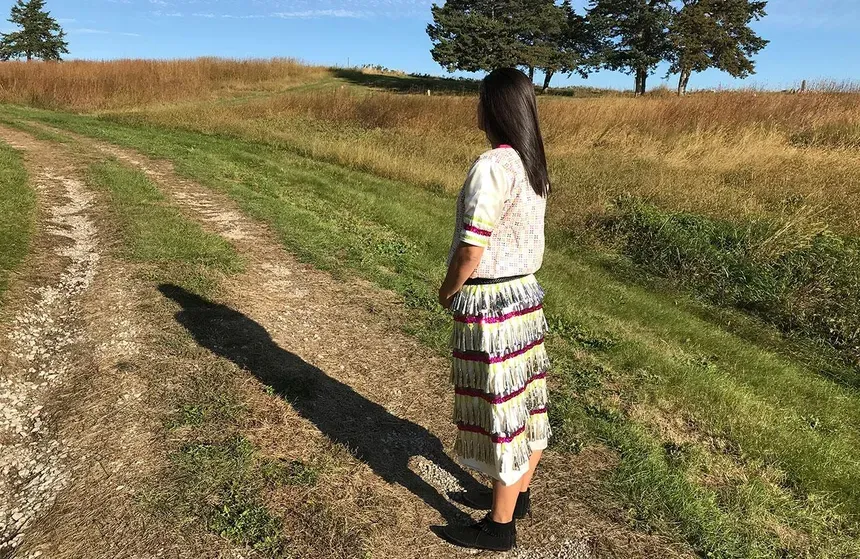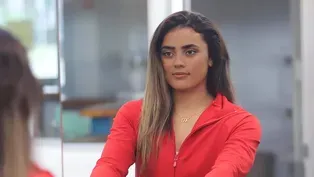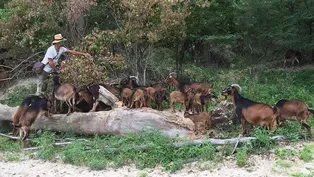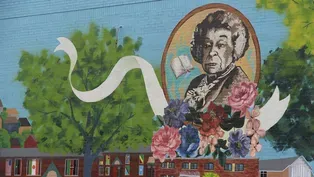
The G.O.A.T. Mission and More
Season 13 Episode 1 | 27mVideo has Closed Captions
Saving a rare breed of goats, South Omaha murals and more await you on this episode.
On this episode of Nebraska Stories, two men are on a mission to save a rare breed of goat, colorful murals in South Omaha, a Husker volleyball player who survived two brain tumors, and a look at the American Dipper, the only aquatic songbird in North America.
Problems with Closed Captions? Closed Captioning Feedback
Problems with Closed Captions? Closed Captioning Feedback
Nebraska Stories is a local public television program presented by Nebraska Public Media

The G.O.A.T. Mission and More
Season 13 Episode 1 | 27mVideo has Closed Captions
On this episode of Nebraska Stories, two men are on a mission to save a rare breed of goat, colorful murals in South Omaha, a Husker volleyball player who survived two brain tumors, and a look at the American Dipper, the only aquatic songbird in North America.
Problems with Closed Captions? Closed Captioning Feedback
How to Watch Nebraska Stories
Nebraska Stories is available to stream on pbs.org and the free PBS App, available on iPhone, Apple TV, Android TV, Android smartphones, Amazon Fire TV, Amazon Fire Tablet, Roku, Samsung Smart TV, and Vizio.

Do you have a Nebraska Story?
Do you have a story that you think should be told on Nebraska Stories? Send an email with your story idea, your name, your city and an email address and/or phone number to nebraskastories@nebraskapublicmedia.org. Or, click the link below and submit your information on nebraskastories.org.Providing Support for PBS.org
Learn Moreabout PBS online sponsorship- [Narrator] Coming up on Nebraska Stories, two farmers on a mission to save rare goats, South Omaha's rich cultural history, celebrated in murals, a Husker's Aloha Spirit inspires her in the game of life, and North America's only aquatic songbird.
(upbeat rock music) (rooster crows) - [Chad] Welcome to Willow Valley Farms.
We're going to take you guys on a goat walk, I walk these goats twice a day.
- [Dennis] Chad Wagener is a modern day goat herder.
He starts and ends every day by walking these goats out to pasture, and then back again.
- Time for breakfast.
(goats bleat) Time for breakfast.
There, they know what time it is.
They're like, "Let's go daddy."
- The goats he cares for are family to him.
He knows each one, and many have names like "Blessing", "Sophie", "Sylvia", or "Broken Horn".
- This little guy is just a couple days old.
What are you doing?
Welcome to planet Earth.
(Chad to goats) "Let's go!
Good job!"
- Chad will tell you each goat is unique, with it's own personality.
But as a breed, they're also unique.
These are San Clemente Island goats.
There's estimated to be fewer than 1,500 of them in the world, and the single largest herd, 250 of them, are here on this farm in rural Gretna, Nebraska.
- I take it for granted sometimes, but then I also sit back and I think wow, look at these goats.
- The goats get their name because about a century and a half ago there were believed to be as many as 18,000 of them living on the small San Clemente Island off the coast of California.
When they started to overrun the island's natural ecosystem, an eradication program was started, until only a small breeding population returned to the mainland.
So how does this breed of goats get from a small island in the Pacific Ocean more than 1,000 miles away to a 40 acre farm in the Elkhorn River Valley in Nebraska?
Chad and John Carroll are the reason.
The couple started contacting breeders across the country to obtain the goats, slowly building their herd of one of the rarest goats in the world.
Chad had been in pharmeceutical sales before turning his attention full time to the goats.
John has been a medic in the Air Force, a registered nurse, and is now an attorney in Omaha.
And he quickly adds, a goat farmer.
- We started out with two goats, you know it's like two goats, and then we got to 20 and now we're at like 250 plus.
When I see Chad out there shepherding the goats They follow him everywhere, they're like one unit.
It reminds me of like, Italy, or those European countries where shepherds took their flock, or their herd, and walked around.
- Those walks allow the goats to stretch their legs, Chad says, often climbing up to munch on tree leaves along the way.
It's exercise for the goats, and Chad says for him, it's a daily therapy session in the middle of a field.
He calls it his "happy hour".
- [Chad to goats] Let's go!
- I'm part goat, maybe that was my calling, to do this.
I think it's because I spend a lot of time with the goats, they know my voice, they know my smell because I smell like them most days.
I think the reason these goats are so comfortable with me is, I spend a lot of time just doing this, I sit down with them, in their environment.
I want to be one of them and understand what it's like to be one of them.
Just as much as I hope they want to be like me one day.
- There's a word Chad uses often when describing his relationship with the goats.
- I use the word "symbiotic".
Not only with the goats, but with all the living things.
The trees, the bees, the butterflies, the plants.
Especially these guys.
Whether it's good for the soul, good for the health of these goats and the planet, or the soul and the health of us as humans, it's very symbiotic.
- It's not just about the good feelings they get, though.
Chad and John are doing this to make a difference.
They want to see the San Clemente Island breed of goats increase in numbers and flourish.
They're looking for more serious breeders who want to share that mission.
- We recognize that, now that we've got the numbers, we need to find people who really don't want just two or three, you know, and just eating weeds and things like that, we want them to really want to breed them.
- They believe another way to increase the number of these goats is to show they have value.
John and Chad have a long term plan they think will do just that.
- [Chad] As with any critically endangered animal, we need to come up with a value-add or purpose.
Of course they have a great set of genetics, but what we specifically want to do is create that value by building a dairy and showing non-San Clemente Island goat breeders and milkers that these guys can be milked and make a really good cheese.
And that would be a value-add which would help for the sustainability of this goat and keep them from going extinct.
- It would be the first ever commerical milking goat dairy for San Clemente Island goats.
There would be a storefront, a milking parlor, and a cheese room.
- For those that want to make a boutique, niche cheese the butter fat is very high, and I think it actually will make a really high quality cheese.
- The dairy would also serve as a real world classroom, and the subject matter would be San Clemente Island goats.
- The whole Maya Angelou "When you get, give.
When you learn, teach."
So bring different groups and educate them, whether it's children, at-risk children, LGBTQ youth, local elementary kids, bring them in and let them see us cheese, let them help us milk and do some of that in this area.
- We've just got to figure out how to make this happen, and it takes money, you know and learning how to do it and all that, so we're just inching our way that way.
- John and Chad may be the best chance the San Clemente Island goats have to survive, which is exactly why they call this their passion project.
- We feel like if we can do this, we're going to find an outlet for these goats to save them.
- I think that if you ask almost any one of our family members, they think John and I are crazy.
Why are you doing this, what are you doing that for, why are you spending all that money on it?
And I think that one day we'll prove them wrong.
When I have that goat dairy up and you and I are sitting there eating goat cheese, maybe drinking a glass of wine, we'll toast to this interview and we'll toast to our family and say, "told you so".
(steady rock music) (melodic guitar music) - One thing that was unique about South Omaha was the diversity of all the different ethnic groups that were down here.
So in a way it's a microcosm of America.
The stockyards came here first and the people developed neighboorhoods around the stockyards.
In the small 6x10 mile area, diversity, to a large degree, got along simply because they were all in the same smell, all with the same flies, all with the same hard work.
I was doing tours of South Omaha with the Durham for Ollie the Trolley.
And a lot of times when I was doing these tours, a lot of people didn't want to come back down to South Omaha even though they were from there because they'd say it's not the South Omaha that I knew.
If we could give them something that could actually be kind of a visual of the South Omaha they knew, we could convince more people to start coming down to South Omaha, and we could give tours of it.
The most important thing it does is, it really enhances the concept of diversity, and it also reinvigorates the idea of the immigrant experience.
So I thought it would be neat not just to have a South Omaha mural, but to actually distinguish the different groups that related together.
And as you go through the murals you're going to see a connection there.
And you're also going to see an importance of what really, you can tell each group and what their identity was down here, and what they excelled in what they were good at.
- One of the main things that I want people to really understand about our mission, is that we aren't trying to accentuate the differences between people, what we're trying to do with this is to exemplify the beauty, in our eccentricities and our cultures, and our love of different aesthetic qualities, our love of different songs and music and dance.
Our love of our roots of where we came from.
If we were to ignore that, those differences, then we wouldn't be valuing what they're really bringing to our experience of living here.
And by highlighting them in their own kind of special way, we are able to acknowledge each other as neighbors and as humans who add value to our lives even despite our differences or because of our differences.
- It's a beautification idea also, if you think about it because you have these beautiful murals with these beautiful colors.
My main goal is to bring people back to South Omaha, back to their roots, and also to experience wonderful South 24th Street, where we have the best restaurants, the best people, and the nicest place in the entire city.
(somber piano music) - Each mural we hire at least one or two new people, and that helps our bubble kind of grow.
(muic continues) Because we do want every mural to have a different flavor and a different style, different feelings and values, so it's nice to be able to pass the baton around.
- We don't want them all to look the same, we want them to express a bit about the individual culture.
- Like they'll look up Irish artists and Polish artists and try to get the flavor of the actual art.
They do a calling out for artists, who basically would come in and actually help them.
So for example right now, if you're going to do an African American artist, it'd be good to have an African American artist do the mural.
(gentle guitar music) - We have at least four when we're trying to get from the community any imagery, or any kind of relic from the past.
One of the things about doing a project of this sort, you really need to immerse yourself into that community to gain greater access and to get more information of course, which is pratical.
But also to build trust within that network to kind of really know that community.
The more you know that community, the better able you are to address that community.
- The little seed that we are trying to plant with our work, is to show that with just a little communication and a little collaboration, and talking to your neighbor, and just talking to a few other people, you can really just make this beautiful little thing, grow into something that's yours, that you have claimed that space again, and that empty wall doesn't just have to be a crumbling empty wall, it can be a monument to your neighborhoood.
- One of the things that I think is special about this project is that as new immigrants come in also, one of the things they can do is they can share their history, and become part of it as they create a mural for the new groups, as new groups and new people come, we can all start embracing it.
So what hopefully happens here is because of that is there is an embracing of people coming back and an acceptance of our diversity.
(somber piano music) (steady rock music) (light ukelele music) - Keonilei Akana is a long way from home, but her Hawaiian culture shines bright in the Cornhusker State.
- Growing up, it's a small island, it's a small state, I would say we're very close in the environment because the community is so small.
If I could describe it I would say heartwarming, I would say there's a lot of love and like we say, the Aloha Spirit, it kind of just brings everyone together.
- Growing up in an athletic family, her mom Jocelyn played volleyball for the University of Hawai'i, and her dad Brandon played basketball for BYU Hawai'i.
We tried soccer, gymnastics, we tried every other sport, but finally me and my sister, we asked, and we just said, "Hey like could we please play volleyball, we really want to," so finally she said, "Okay, I'll take you guys to the gym, like whatever" and me and my sister just fell in love with it.
(hyped techno music) - Performing drills, practices, games, her passion grew and over time volleyball became life.
Before Kelei could take her first rep in high school everything was put on hold.
- All of the sudden, like after a run, I was feeling light headed and I was very fatigued, and I ended up passing out.
And so, being rushed to the hospital, my parents and my family, they were just very concerned, they didn't know what was going on.
Later on we found out that I had a tumor on the left side of my brain and it was a benign.
But at the same time my parents were very concerned, wondering if they could take it out or if it could be removed.
So that was the first time that we found out there was a tumor and there was something wrong.
- After beating the tumor, she returned to the court with a new appreciation for volleyball.
Her sophomore year ended with a state championship celebration.
However, early into her junior year, shock and disbelief returned, when she received the news of a second brain tumor.
- Being at such a young age, I went from playing volleyball every single day and just loved being on the court.
When I had to go into surgery I kept asking could I get back on the court, could I just play volleyball please.
The doctors just kept telling me no, your health is so important and it's something that you really need to think about.
That's why I think, like looking back I wouldn't take it away, and I'm just grateful it was part of my path because it really helped me mature and understand that my health is very important also.
- [John] There hasn't been a day yet that I've seen that she is just not putting in everything every second that she's in that gym, I think that comes from that so that's helped develop her drive to be great and appreciate this opportunity, so I think it's a great role model for the rest of our players.
She's overcome a lot and that's why she's tough.
- It's really helped me become who I am and also see the positive in things.
Coach Cook wanted us to find our "why" and the reason why we do play volleyball, and my answer was to inspire those who also had to go through medical situations as me, whether it be a boy or a girl, and just understanding that you can conquer anything you want if you put your heart to it.
(gentle music) (gentle music) (engine rumbling) (rain pattering) - [Driver] Welcome to the mountains.
Hail here, blue sky up there.
(laughing) - [Voice] Steve's a character.
Steve's one of those guys that I'm sure comes into a lot of people's minds.
He grew up in Nebraska.
He grew up out in the plains, but he came up into the mountains and into this Canyon 30 some years ago and never left.
I got to know him trying to figure out dippers, and Steve spent a lot of time looking up and down this canyon for nests, and he'd name every single nest, and then he'd report to me what the names of those nests were and where they were.
After a while, I said, "I've gotta meet you, and you've gotta show me this stuff in person."
The American Dipper is North America's only aquatic songbird.
It's a trout with feathers is what it is.
If you find dippers in a place, then that means that the water quality's good.
They make their lives in this very violent world, yet they are soft and elegant.
They're really beautiful.
They're sort of like the wildlife that's right under your nose, that you see but you really don't think much about.
That's what I like to try to do, just try to help people understand a little bit more about the stuff that they see so that maybe they can care too.
- [Woman] So where are we stopping now?
- Oh, a dipper next.
This is the first dipper nest I showed Mike several years ago.
- [Woman] Does it have a name?
- Yeah, it's got a great name.
They all have names.
This one's called Stairway to Heaven.
I'm a rocker, you know?
(laughs) Come, I shall show you the Stairway to Heaven.
Remember this one, Mikey?
- [Mike] Oh, I do remember.
We became very fast friends, and he and his friends down at Poudre Park and other people up in this canyon are the stewards of this river.
Yeah, he's a good guy.
(gentle upbeat music) (traffic roaring) - [Steve] And this is the Den.
Welcome to the Den.
(gentle upbeat music) (Steve grunts) And I shall meet you out back.
I bought this place in 1986.
This is my 32nd year.
I'm a birdwatcher, I've been my whole life.
I've netted, and identified, and aged, and sexed over 10,000 birds, banded them as a hobby of mine, and so I knew what dippers were, but it wasn't until I bumped into Mike that I've learned more about them.
I talked to all four of you, but I was looking at the guy, Tyler.
I said, "Yeah, I'm excited, Mike is gonna come out.
He's got one more picture to take.
He wants to get a dipper under water."
He smiles, and he goes, "Steve, Michael always has one more picture to take.
He'll always have one more picture to take," and I thought, yep, that's Mikey.
He'll get it.
It's his passion, it's his patience.
(gentle upbeat music) - [Mike] The goal for today has been my goal for four years, (laughing) which has been to try to photograph these dippers underwater.
With wildlife work, you just have to be incredibly persistent.
I hate electronics.
(sighs) And you have to accept failing on a fairly regular basis.
(whimsical music) This is gonna drive me nuts now, the next two hours.
(laughing) They're gonna go right to where I was.
That's exactly how it works.
You've gotta be patient.
You gotta trust it, and then be willing to fail every day.
I got a whole lot of nothing, but I got really close, which is usually how it is.
That bird's pretty close.
I really want that photograph underwater, and that's really, really hard, and I've failed miserably for a long time, but I keep getting closer, and closer, and closer, so maybe one day.
(whimsical music) Here comes a bird.
Are you gonna land on that rock, dude?
(whimsical music) Well gang, if we didn't get it there, I'm just gonna give up.
The bird swam and dove right in front of that housing.
(whimsical music) Alright.
I really wanna open this, but I really don't wanna open this.
I see the dipper.
I see tops of legs, is what I see, (laughing) which is pretty funny.
It's sort of small in the frame, though.
(whimsical music) Okay, there it's swimming, so we get it on the left side.
It's sort of going out of frame.
Oh man.
Oh man, just missed.
Got everything but the front of its head going out of the frame, got bubbles around it.
Okay.
Well, it's not like the killer image.
It's not the one that you paint.
It's cool.
It's a start.
I can't stop yet.
But it works, everything looks good.
The light looks good, exposure's good, so we're close.
We've gotta get this back out there.
(water rushing) - Oh, wow!
Is that cool, or what?
- [Mike] Wanna see it again?
- [Steve] Yeah.
- [Mike] Look, it just keeps flapping to stay down, you know?
You see all those bubbles coming off of that bird?
And then he just catches the current and starts paddling.
(Steve laughing) Isn't that something?
- And you want more?
- Well, you know, you can always see something else, you know?
(gentle acoustic guitar music) (bird chirping) (upbeat music) NARRATOR: Watch more Nebraska Stores on our website, Facebook, and YouTube.
Nebraska Stories is funded in part by the Margaret and Martha Thomas Foundation.
(upbeat music)
Video has Closed Captions
Clip: S13 Ep1 | 3m 36s | Husker Volleyball player Keonilei Akana (3m 36s)
Video has Closed Captions
Clip: S13 Ep1 | 6m 57s | Gretna farmers who are saving rare San Clemente Island goats. (6m 57s)
Video has Closed Captions
Clip: S13 Ep1 | 6m 59s | Murals depict the diverse cultural communities in South Omaha. (6m 59s)
Providing Support for PBS.org
Learn Moreabout PBS online sponsorshipSupport for PBS provided by:
Nebraska Stories is a local public television program presented by Nebraska Public Media














